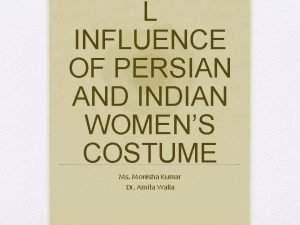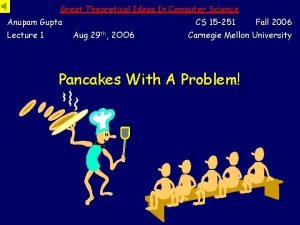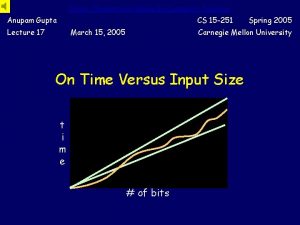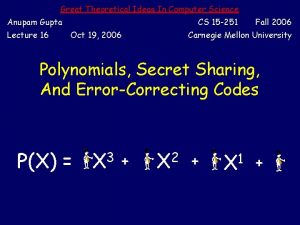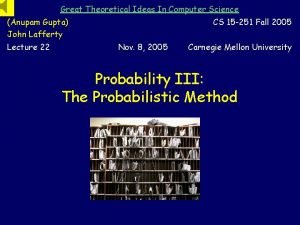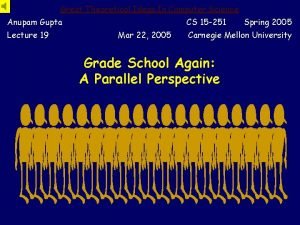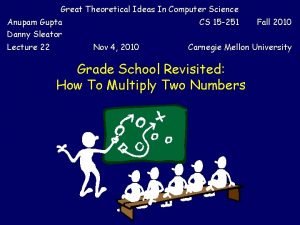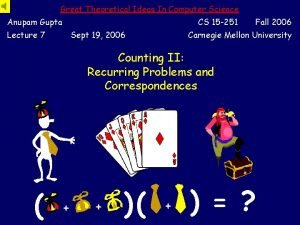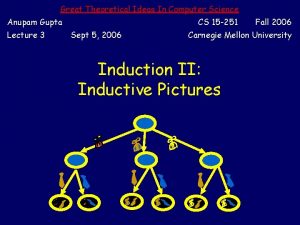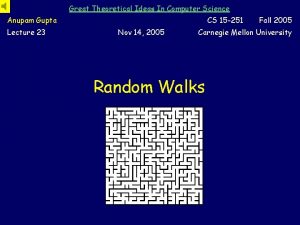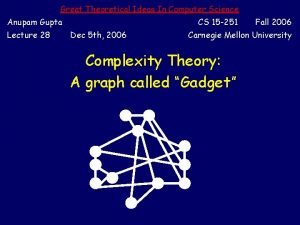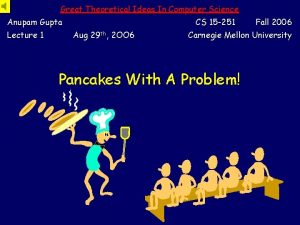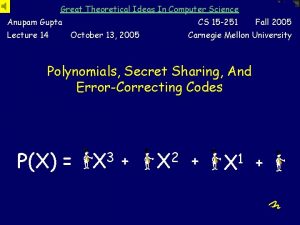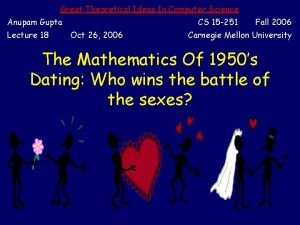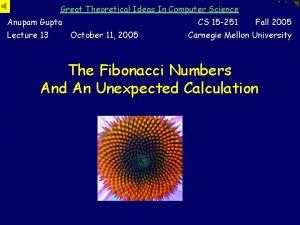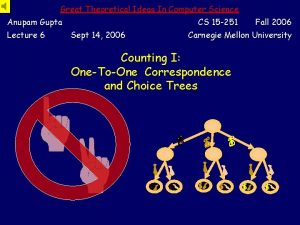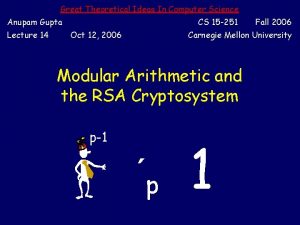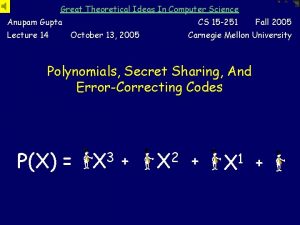Great Theoretical Ideas In Computer Science Anupam Gupta

















































- Slides: 49

Great Theoretical Ideas In Computer Science Anupam Gupta Lecture 18 CS 15 -251 Oct 26, 2006 Fall 2006 Carnegie Mellon University The Mathematics Of 1950’s Dating: Who wins the battle of the sexes?

WARNING: This lecture contains mathematical content that may be shocking to some students.

3, 2, 5, 1, 4 3, 5, 2, 1, 4 1 1 5, 2, 1, 4, 3 1, 2, 5, 3, 4 2 2 4, 3, 5, 1, 2 4, 3, 2, 1, 5 3 3 1, 2, 3, 4, 5 1, 3, 4, 2, 5 4 4 2, 3, 4, 1, 5 1, 2, 4, 5, 3 5 5

Dating Scenario There are n boys and n girls Each girl has her own ranked preference list of all the boys Each boy has his own ranked preference list of the girls The lists have no ties Question: How do we pair them off? What criteria come to mind?

3, 2, 5, 1, 4 3, 5, 2, 1, 4 1 1 5, 2, 1, 4, 3 1, 2, 5, 3, 4 2 2 4, 3, 5, 1, 2 4, 3, 2, 1, 5 3 3 1, 2, 3, 4, 5 1, 3, 4, 2, 5 4 4 2, 3, 4, 1, 5 1, 2, 4, 5, 3 5 5

There is more than one notion of what constitutes a “good” pairing. Maximizing total satisfaction Hong Kong and to an extent the United States Maximizing the minimum satisfaction Western Europe Minimizing the maximum difference in mate ranks Sweden Maximizing number of people who get their first choice Barbie and Ken Land

We will ignore the issue of what is “equitable”!

Rogue Couples Suppose we pair off all the boys and girls. Now suppose that some boy and some girl prefer each other to the people to whom they are paired. They will be called a rogue couple.

Why be with them when we can be with each other?

Stable Pairings A pairing of boys and girls is called stable if it contains no rogue couples. 3, 2, 5, 1, 4 1, 2, 5, 3, 4 4, 3, 2, 1, 5 1, 3, 4, 2, 5 1, 2, 4, 5, 3 1 1 2 2 3 3 4 4 5 5 3, 5, 2, 1, 4, 3, 5, 1, 2, 3, 4, 5 2, 3, 4, 1, 5

Stable Pairings A pairing of boys and girls is called stable if it contains no rogue couples. 3, 2, 5, 1, 4 1, 2, 5, 3, 4 4, 3, 2, 1, 5 1, 3, 4, 2, 5 1, 2, 4, 5, 3 1 1 2 2 3 3 4 4 5 5 3, 5, 2, 1, 4, 3, 5, 1, 2, 3, 4, 5 2, 3, 4, 1, 5

What use is fairness, if it is not stable? Any list of criteria for a good pairing must include stability. (A pairing is doomed if it contains a rogue couple. ) Any reasonable list of criteria must contain the stability criterion.

Some unsolicited social and political wisdom Sustainability is a prerequisite of fair policy.

The study of stability will be the subject of the entire lecture. We will: Analyze various mathematical properties of an algorithm that looks a lot like 1950’s dating Discover the naked mathematical truth about which sex has the romantic edge Learn how the world’s largest, most successful dating service operates

Given a set of preference lists, how do we find a stable pairing? Wait! We don’t even know that such a stable pairing always exists!

A better question… Does every set of preference lists have a stable pairing? Is there a fast algorithm that, given any set of input lists, will output a stable pairing, if one exists for those lists?

One question at a time Does every set of preference lists have a stable pairing?

Idea: Allow the pairs to keep breaking up and reforming until they become stable.

Can you argue that the couples will not continue breaking up and reforming forever?

An Instructive Variant: Bisexual Dating a. k. a. roommate selection 2, 3, 4 1 3, 1, 4 2 1, 2, 4 *, *, * 3 4

Insight Any proof that heterosexual couples do not break up and re-form forever must contain a step that fails in the bisexual case If you have a proof idea that works equally well in the heterosexual and bisexual versions, then your idea is not adequate to show the couples eventually stop.

The Traditional Marriage Algorithm

The Traditional Marriage Algorithm Female Worshipping males String

Traditional Marriage Algorithm For each day that some boy gets a “No” do: Morning Each girl stands on her balcony Each boy proposes under the balcony of the best girl whom he has not yet crossed off Afternoon (for those girls with at least one suitor) To today’s best suitor: “Maybe, come back tomorrow” To any others: “No, I will never marry you” Evening Any rejected boy crosses the girl off his list If none of the boys gets a “No” Each girl marries the boy to whom she just said “maybe”

Does the Traditional Marriage Algorithm always produce a stable pairing? Wait! There is a more primary question!

Does TMA always terminate? It might encounter a situation where algorithm does not specify what to do next (a. k. a. “core dump error”) It might keep on going for an infinite number of days

Traditional Marriage Algorithm For each day that some boy gets a “No” do: Morning Each girl stands on her balcony Each boy proposes under the balcony of the best girl whom he has not yet crossed off Afternoon (for those girls with at least one suitor) To today’s best suitor: “Maybe, come back tomorrow” To any others: “No, I will never marry you” Evening Any rejected boy crosses the girl off his list If none of the boys gets a “No” Each girl marries the boy to whom she just said “maybe”

Improvement Lemma: If a girl has a boy on a string, then she will always have someone at least as good on a string (or for a husband). She would only let go of him in order to “maybe” someone better She would only let go of that guy for someone even better AND SO ON. . . Informal Induction

Improvement Lemma: If a girl has a boy on a string, then she will always have someone at least as good on a string (or for a husband). Proof: Let q be the day she first gets b on a string. If the lemma is false, there must be a smallest k such that the girl has some b* inferior to b on day q+k. But then, one day earlier, she has someone as good as b. Hence, a better suitor than b* returns the next day. She will choose the better suitor contradicting the assumption that her prospects went below b on day q+k. Formal Induction

Corollary: Each girl will marry her absolute favorite of the boys who visit her during the TMA

Lemma: No boy can be rejected by all the girls Proof by contradiction. Suppose boy b is rejected by all the girls. At that point: Each girl must have a suitor other than b (By Improvement Lemma, once a girl has a suitor she will always have at least one) The n girls have n suitors, b not among them. Thus, there at least n+1 boys Contradicti on

Theorem: The TMA always terminates in at most n 2 days A “master list” of all n of the boys lists starts with a total of n X n = n 2 girls on it. Each day that at least one boy gets a “No”, at least one girl gets crossed off the master list Therefore, the number of days is bounded by the original size of the master list. In fact, since each list never drops below 1, the number of days is bounded by n(n-1) = n 2 -n.

Great! We know that TMA will terminate and produce a pairing. But is it stable?

Theorem: Let T be the pairing produced by TMA. Then T is stable. I rejected you when you came to my balcony. So now I’ve got someone better. g b g*

Theorem: Let T be the pairing produced by TMA. Then T is stable. Let b and g be any couple in T. g b g* Suppose b prefers g* to g. We will argue that g* prefers her husband to b. During TMA, b proposed to g* before he proposed to g. Hence, at some point g* rejected b for someone she preferred. By the Improvement lemma, the person she married was also preferable to b. Thus, every boy will be rejected by any girl he prefers to his wife. T is stable.

Opinion Poll ff o r e t et nal b is io ys t i o d o h a b r W nt e ? h t i s , l g r i n i g t a e d h t or

Forget TMA for a moment How should we define what we mean when we say “the optimal girl for boy b”? Flawed Attempt: “The girl at the top of b’s list”

The Optimal Girl A boy’s optimal girl is the highest ranked girl for whom there is some stable pairing in which the boy gets her. She is the best girl he can conceivably get in a stable world. Presumably, she might be better than the girl he gets in the stable pairing output by TMA.

The Pessimal Girl A boy’s pessimal girl is the lowest ranked girl for whom there is some stable pairing in which the boy gets her. She is the worst girl he can conceivably get in a stable world.

Dating Heaven and Hell A pairing is male-optimal if every boy gets his optimal mate. This is the best of all possible stable worlds for every boy simultaneously. A pairing is male-pessimal if every boy gets his pessimal mate. This is the worst of all possible stable worlds for every boy simultaneously.

Dating Heaven and Hell A pairing is male-optimal if every boy gets his optimal mate. This is the best of all possible stable worlds for every boy simultaneously. Is a male-optimal pairing always stable? We’ll see…

Dating Heaven and Hell A pairing is female-optimal if every girl gets her optimal mate. This is the best of all possible stable worlds for every girl simultaneously. A pairing is female-pessimal if every girl gets her pessimal mate. This is the worst of all possible stable worlds for every girl simultaneously.

The Naked Mathematical Truth! The Traditional Marriage Algorithm always produces a male-optimal, female-pessimal pairing.

Theorem: TMA produces a male-optimal pairing Suppose, for a contradiction, that some boy gets rejected by his optimal girl during TMA. Let t be the earliest time at which this happened. At time t, some boy b is rejected by his optimal girl g because she said “maybe” to a preferred b*. By the definition of time t, boy b* had not yet been rejected by his optimal girl. Therefore, b* likes g at least as much as his optimal.

Some boy b got rejected by his optimal girl g because she said “maybe” to a preferred b*. b* likes g at least as much as his optimal girl. By definition of “optimal girl”, there must exist a stable pairing S in which b and g are married. b* wants g more than his wife in S g is as at least as good as his best and he does not have her in stable pairing S g wants b* more than her husband in S b is her husband in S and she rejects him for b* in TMA Contradiction of the stability of S.

What proof technique did we just use?

Theorem: The TMA pairing T is female-pessimal. We know it is male-optimal. Suppose there is a stable pairing S where some girl g does worse than in T. Let b be her mate in T. Let b* be her mate in S. By assumption, g likes b better than her mate in S b likes g better than his mate in S We already know that g is his optimal girl Therefore, S is not stable. Contradicti on

The largest, most successful dating service in the world uses a computer to run TMA!

REFERENCES D. Gale and L. S. Shapley, College admissions and the stability of marriage, American Mathematical Monthly 69 (1962), 9 -15 Dan Gusfield and Robert W. Irving, The Stable Marriage Problem: Structures and Algorithms, MIT Press, 1989
 Great theoretical ideas in computer science
Great theoretical ideas in computer science Great ideas in theoretical computer science
Great ideas in theoretical computer science Great theoretical ideas in computer science
Great theoretical ideas in computer science 15 251
15 251 Great theoretical ideas in computer science
Great theoretical ideas in computer science Great theoretical ideas in computer science
Great theoretical ideas in computer science Great theoretical ideas in computer science
Great theoretical ideas in computer science Vocabularize
Vocabularize Great theoretical ideas in computer science
Great theoretical ideas in computer science Great theoretical ideas in computer science
Great theoretical ideas in computer science Great ideas in computer science
Great ideas in computer science Graph theory computer science
Graph theory computer science Anupam ameya supercomputer
Anupam ameya supercomputer Euler-poincaré formula
Euler-poincaré formula Anupam saxena
Anupam saxena Anupam saxena
Anupam saxena 18734 cmu
18734 cmu Eight ideas in computer architecture
Eight ideas in computer architecture Task level parallelism
Task level parallelism Cs61c
Cs61c 8 great ideas in computer architecture
8 great ideas in computer architecture What is your favourite subject?
What is your favourite subject? Ideas have consequences bad ideas have victims
Ideas have consequences bad ideas have victims Ideas secundarias
Ideas secundarias Unit 4 great ideas
Unit 4 great ideas Science national honor society project ideas
Science national honor society project ideas National children's science congress projects ideas
National children's science congress projects ideas Kate rayner
Kate rayner Shambhu gupta & co
Shambhu gupta & co Kinseyprivate
Kinseyprivate Dr himanshu gupta
Dr himanshu gupta Shankar gupta
Shankar gupta Anjum gupta ucsd
Anjum gupta ucsd Dinesh gupta icgeb
Dinesh gupta icgeb Gupta period costumes
Gupta period costumes K+k
K+k Dr sonal gupta
Dr sonal gupta Dr vg gupta surgeon
Dr vg gupta surgeon Navin gupta md
Navin gupta md Kerititis
Kerititis Rupayan gupta
Rupayan gupta Midpoint line drawing algorithm
Midpoint line drawing algorithm Gupta empire philosophy
Gupta empire philosophy Amritdhara pharmacy v. satyadeo gupta
Amritdhara pharmacy v. satyadeo gupta Aseem gupta adq
Aseem gupta adq Kavita gupta md
Kavita gupta md Kedar nath gupta
Kedar nath gupta Dr pulin kumar
Dr pulin kumar Odu linux servers
Odu linux servers Robert hooke
Robert hooke


































